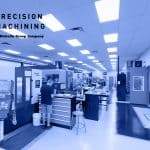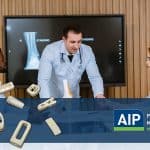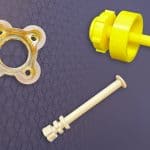Ask the Plastics Professionals at AIP Precision Machining!
Do you know why AIP Precision Machining includes stress-relieving and annealing plastics as part of our machining process? We’ve talked about this a bit in our plastic machining guides (like our polymer machining brief on RADEL, but this post serves as a more thorough explanation of annealing does to improve your machined parts.
What’s the purpose of stress relieving and annealing plastics, then? Read on to learn the answer from the plastics professionals at AIP Precision Machining.
What is annealing, and how does AIP anneal its plastic parts?
Let’s start with the basic definition of annealing: it’s a heat treatment that changes the properties of a material to make it easier to machine. Annealing does this by increasing ductility and reducing hardness for the material.
AIP Precision Machining has programmed annealing ovens for plastics that heat the material above its recrystallization temperature. By maintaining the heat at that specific point, the structure of the material changes to become finer and more uniform. This process relieves internal stresses in the material.
The final part of annealing is allowing the material to cool back down once after it’s been heated for a suitable amount of time. Proper annealing requires precise temperatures and timing control to accomplish the right result, which is why AIP uses computer controlled annealing ovens for plastics.
Why is annealing & stress-relieving crucial for plastics?
While not every machined component has to rely on annealing, we at AIP believe it is an important part of the plastic machining process for several reasons. For one thing, it reduces stress in the material.
Plastics that experience internal stress can turn out warped or cracked, have inferior physical properties, or finish with unexpected changes in their part dimensions. Obviously, we want to avoid this as much as possible.
Reducing stress enhances the mechanical and thermal properties of a material by limiting the opportunity for cracking and other issues like the ones above. Since stress build-up can lead to part failure or reduced performance, stress-relieving improves the overall quality of your product.
By doing this, annealing extends the life of your machined plastic parts and components.
Is the process of annealing plastics the same for different materials?
Not at all. Some engineering plastics like ULTEM and TORLON benefit enormously from post-machining annealing. At AIP, proper annealing of TORLON can require more than seven days in special ovens!
Other materials that will undergo a lot of machining time, like some applications of PEEK, can require more intermediate annealing steps to make sure they maintain critically tight tolerances and flatness.
That means it’s essential for your machinist to know what plastic material you’re working with and what particular needs it has. Be sure you’re working with an experienced plastics manufacturer like AIP or else you risk having a lower quality product.
With over 35+ years of experience working with hundreds of polymers and composites, we’re more than just familiar with the machining process. We’re ready to handle any geometry and any challenge.
Want to Learn More about Plastic Machining?
You can follow AIP Precision Machining on LinkedIn, Twitter, Facebook or Google+, so that you can keep up with the latest from the plastics professionals!






